Revolutionary Tennis |
||
Tennis Instruction That Makes Sense |
||
Step 6 Tennis Stroke Commonalities: Lots of Useful Stuff Hit Through The Middle Of The Ball 2 Directions For 1 Contact Ultimate Striking Theory Racket Acceleration Everyone wants a faster, or quicker, stroke. Everyone wants to hit a heavy ball, hit it hard, place it well, and do it all consistently. And no one wants to work too hard to achieve these results. To enhance stroke speed with a pattern that can be repeated consistently with the least amount of work, what matters is how your arm and racket and stroke are configured the moment you strike the ball, not what your stroke looks like after you've hit the ball. In order to form a stroke pattern mentioned above, I'm assuming you've moved into the ball with four steps (Steps 1, 2) to place the contact between the width of the feet ( Step 3) and transfer power with linear momentum (Step 4) while keeping centered and balanced (Step 5). HIT THROUGH THE MIDDLE OF THE BALL
You've been told that hitting through the middle of the ball produces head-on contact for power and control, but the popular stroking direction in books and tennis tips produces the opposite effect. The popular stroking direction you've seen before is an arrow either perpendicular to the net, 6A, or drawn down the middle of a street. The caption states the stroke's direction follows this arrow with the racket parallel to the net at contact, but this direction produces miss-hits. IT'S SIMPLE GEOMETRY It's true that what you learn in school becomes useful in adulthood. Especially math. The middle of a round ball lies in a number of directions, but when it's moving the middle lies per the direction in which it's moving (center of mass in motion). Think of head-on contact between a ball and racket as two cars in a head-on collision. From one direction comes a tennis ball, from another a tennis racket face, and they both impact head-on, or squarely. A tennis ball moves on an angle across the court, Step 1 . Hitting through the middle of a tennis ball, then, means a stroke direction against, or into, the ball's incoming angle. Let's transfer this image to a 2 dimensional bird's eye view used before. The stroke's direction through the middle of the ball is to be drawn per the ball's flight line, not perpendicular to the net, 6B. To ensure head-on contact, the racket face forms a right angle at contact to the ball's flight line. In 3 dimensions you have topspin and slice, but they too hit head-on with either an open or closed racket face for solid contact. Swinging straight to and/or keeping the racket face parallel to the net doesn't place the ball and racket in a head-on collision. Your stroke is unsupported and weaker with this popular idea. 2 DIRECTIONS FOR 1 CONTACT You may have figured this out on your own, what I think could be the most meaningful secret to the game. When you shift your weight linearly into the contact spot, Step 4, and the stroke pattern heads through the middle of the ball toward the opponent's side of the court, 6B, 2 distinct directions are involved. Diagram 6C combines these 2 directions.
Your body shifts weight for power in tennis using linear momentum, not angular momentum (rotating the hips/shoulders), Step 4.. You shift linearly into the ball and not "linearly" with the ball's flight to the opponent's court. Now the example of hitting a ball on-the-run comes into sharper focus. 2 clear and distinct directions are involved for body and stroke hitting on-the-run moving either forward into the court or off the side. The empowerment structure (body) heads into the ball/contact, and the delivery structure (stroke) heads towards the other side of the net. I'm aware that the body's extra momentum when hitting on-the-run covers up a host of sins. But I believe extreme examples often provide insight, as this example has for movement, footwork, contact zone, and power delivery methods in earlier Steps. After all, when you start a rally by bouncing and stepping into the ball, you're enacting 2 direction for 1 contact, on a slower basis. WHAT ABOUT BODY ROTATION DURING THE SWING? The swing has the potential of ruining the body's foundation and support, Step 5 . Its angular momentum and acceleration can pull the body away from the ball prior to and during contact because it heads in a direction separate from the body's focus (into the ball/ contact).
The swing's trajectory is basically an arc. Arcs accelerate from a common origin in a direction inward from their trajectory. The common origin is our shoulder to begin with, and the direction inward means inward from the contact spot, 6D, which is why 6B's head-on stroking direction feels solid and strong. This direction inward from the contact spot sends the ball back in the same direction, often more to that one side. There are times when you send the ball outward from the contact spot. Here the shot is weaker and the risk of losing control is greater: hitting inside-out, changing the ball's direction (though Step 7 explains when changing the ball's direction plays to the stroke's strength), or responding to a sharply crosscourt ball (unless you hit it even more sharply crosscourt). Generally speaking, hit your best shot, through the middle of the ball. If you choose not to, understand the risk involved and don't go all out. If the body rotates after the contact it's okay. This happens, the body doesn't remain still like a statue, the stroke pulls at you. However, if the body rotates during the swing, during contact as part of the swing for power, both power and control are sacrificed. You need to separate the empowerment structure from the delivery structure. ULTIMATE STRIKING THEORY The ultimate striking theory is simply understood. Boxers and martial artists train to generate a large a burst of energy over a small period of time and space. No large, looping, roundhouse punches for these athletes, but short, compact, deep, effective strikes. Quick. Heavy. Earlier I've used the examples of Muhammad Ali's "invisible" knockout punch over Sonny Liston, and Bruce Lee's two-inch punch (or however small in length it really was). By the same token, you don't need a large bomb to deliver the biggest of bangs anymore. The ultimate strike is not of great length, and its force extends beyond its target. Ball placement has always been considered the target in tennis, but it's the second target, if not the objective. The first and primary target is and has always been the ball at contact. A tennis player focuses everything s/he does into the contact (footwork, power, vision, stroke), and then places the ball. BEYOND THE BALL I haven't personally broken any bricks or boards with my hands, but martial artists say they focus not on the top surface of the board but beyond it, past it. When breaking through cinder blocks stacked on top of one another, the athlete focuses on a point beyond the last block. Furthermore, a martial artist focuses on the forward strike's acceleration, creating a burst of energy to break the blocks.
Roll the mouse over diagram 6E to see hitting beyond the ball. A popular tennis idea wants you to hit through three tennis balls instead of one to hit "through" the ball. This image still has you focusing on the ball's surface facing you. Instead, focus beyond the ball for greater effect. RACKET ACCELERATION Step 5 said: "To help the swing accelerate and enjoy the most strength and support from the body, the body doesn't move. Except for the swinging arm, of course. Your front shoulder remains still up through contact, 5J, acting as a brake against the force of the stroke to accelerate it. Rotation, besides moving you away from the ball and being a complicated power source unnecessary for tennis, creates friction during the swing and slows it down." Now we'll add up what we've learned here in Step 6. A stroke's acceleration lies in a direction inward from the contact spot, 6D, and is greatest when there is a common origin, our shoulder and then elbow, in our case. [Extend your arm straight away from your body, keep your shoulder still, and swing the arm side to side. Next, move your shoulder side to side and swing the arm. Compare the two speeds. When the common point, the shoulder, is still, the arm accelerates more. Furthermore, the arm pivots around this common point.] When you swing the racket and move the shoulder(s) around you lose acceleration because the common point moves. The same happens when you shift your weight along the flight line of the ball, or when you rotate, the common point moves. I've said it before, and I'll say it again: Rotation for tennis players is counterproductive to success. DON'T BE A STROKE GUZZLER Don't be a stroke guzzler. The idea is not to waste a natural resource, the arm, like an inefficient automobile engine wastes gasoline. You become a stroke guzzler when the arm moves too much as a whole, or when the arm is engaged as one unit and doesn't flex during the swing. Let's use the same example above where you extended the arm straight away from you and moved it side to side keeping the shoulder still. Do it again and notice the speed at which your hand moves. Stop, then bring the elbow in to touch your stomach and move only the forearm side to side. The hand moves faster, doesn't it? During a tennis stroke the shoulder is the first common point but you can't swing the racket with your arm completely extended or straight and expect good results. It's too slow, plus there's no leverage with the arm this way. You don't pick up a box with your arms straight, do you? The sequence of photos in 6F shows the arm extended away from you during the swing. The elbow, then, becomes a second common point, or pivot point, during your swing. As you begin your forward swing the arm bends to pivot at the elbow, bringing the elbow in closer to the side of your body, and the biceps slows down. Here the shoulder relinquishes its role as the common point and passes the torch to the elbow, whose deceleration helps the racket accelerate more. On forehands the elbows passes the torch to the wrist, but not on backhands. The photo sequence in 6G shows the arm coming in closer to the body during the forward swing. MORE ACCELERATION All in all the arm's parts compress into the body (to reduce their moments of inertia to increase the stroke's angular momentum) in an effort to whip the racket face around the arm and the body as fast as possible to hit the ball head-on. In a not so small way, this is similar to an ice skater spinning in a circle with her arms extended who then brings them in to spin faster. Of course we don't spin around, but for the small moment of a forward swing, the arms come in closer to the body to increase our racket's forward acceleration.
WHAT ABOUT THE PROS?
The 6H photo on the right shows adherence to the arm's leverage dynamic: the elbow drops and the arm comes in closer to the body for leverage and speed, and will resemble 6F top photo right during the forward swing. Though some pros extend laterally on their forehands, it's definitely more the exception than the rule. On forehands you have to get closer to the ball than you're used to because stretching, or extending, equals leverage loss. And on backhands you have to resist straightening the arm as part of the stroke's objective because that, too, equals leverage loss.
A SIMPLE TENNIS QUIZ What hits the ball? Quickly, answer. It's not the racket, it's the racket's face, or strings. Keep this in mind. What part of your body swings the racket? Answers have been shoulder, arm, chest, body. Well, the racket is not connected to any of those points. The shoulder doesn't swing the racket any more than the arm. The hand does. Your hand, then, swings what to hit the ball? The racket? No, that doesn't hit the ball. The hand swings... the strings. Okay, end of quiz. Many popular stroking ideas inhibit acceleration, such as extending the arm out away from your body, straightening the arm for the contact, reaching out to the side, swinging from the shoulder. My favorite is swinging the arm to swing the racket, which is the cart pushing the horse. The arm is bent at contact, never straight, even on backhands. It straightens momentarily after contact, like it does the moment after your throw a ball. The arm doesn't straighten for an effective swing any more than it straightens to throw a ball. On backhands the arm is folded across the stomach, unfolds during the swing, and is bent after contact. The hand flexes at the wrist on forehands. There's a natural spring to the wrist on a forehand, a bit of a throwing motion, and it becomes the last common point after the elbow to help accelerate the racket head into the ball. The wrist is to be used, not abused, it doesn't flop or break as on serves and overheads. Wristy is the wrong way to describe using the natural spring the wrist provides, and without it the forehand doesn't mature. A popular idea it to keep the wrist stiff on a forehand to commit fewer errors. While there is literal truth to that reasoning, this kind of forehand isn't a weapon and leads to arm or shoulder injury since you're denying the natural spring of the wrist. Okay, you're ready to hit the ball, but have you been looking at the ball clearly in 3 dimensions to time it right? Odds are the answer is no, especially on your backhand. And where will you hit it, have you decided? Will you hit it into the open court, behind your opponent, to his weak side? Why waste your time thinking about such things when you should be looking at the ball and playing to your shot's strength, regardless of your opponent's position or weakness? PART II follows in Step 7
|
||||||||
|
|
||||||||||||||||||||||||||||||||||||||||||||||||||||||||||||||
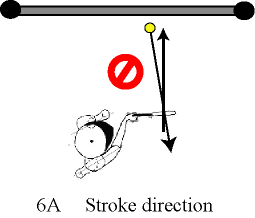
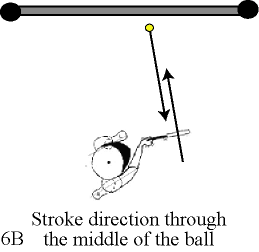
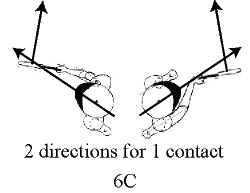 You shift your weight into the contact spot, into the ball; the stroke heads through the middle of the ball toward your opponent. 2 directions for each contact.
You shift your weight into the contact spot, into the ball; the stroke heads through the middle of the ball toward your opponent. 2 directions for each contact.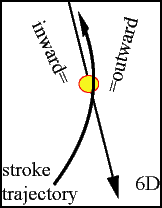
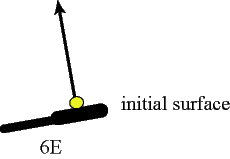
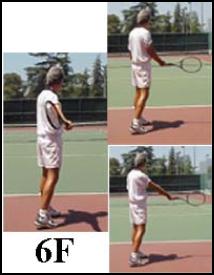 6F, left photo, shows the arm extended with the racket back. 6F top photo shows the arm coming in closer to the body during the forward swing for leverage dynamics, what you want. 6F bottom shows what to avoid, the arm extending away from your body laterally during the forward swing. 6G shows the arm folded, then unfolded during the swing for backhands in order to maintain leverage dynamics, you don't want to swing the arm straight out away from you. It's the same for two handed backhands, even though there are styles where the arms straighten and the wrists (not the elbows) act as the pivot points.
6F, left photo, shows the arm extended with the racket back. 6F top photo shows the arm coming in closer to the body during the forward swing for leverage dynamics, what you want. 6F bottom shows what to avoid, the arm extending away from your body laterally during the forward swing. 6G shows the arm folded, then unfolded during the swing for backhands in order to maintain leverage dynamics, you don't want to swing the arm straight out away from you. It's the same for two handed backhands, even though there are styles where the arms straighten and the wrists (not the elbows) act as the pivot points.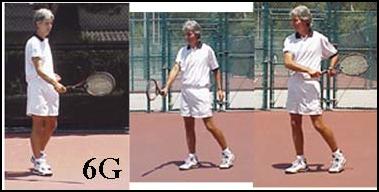
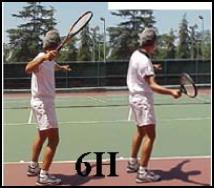 Photo 6H, right, shows the arm placement a pro often uses when taking the racket back on the forehand. The elbow is up high, the arm is drawn back in exaggerated form, the body's coiling, the stance is open. But they, too, from this position, must adhere to the arm's leverage dynamics. If they don't, and a lot of them don't, their forehands aren't what they want them to be. The exaggerated use of the arm during a pro's swing is a symptom of inefficiency, much like low gas mileage for a large automobile engine.
Photo 6H, right, shows the arm placement a pro often uses when taking the racket back on the forehand. The elbow is up high, the arm is drawn back in exaggerated form, the body's coiling, the stance is open. But they, too, from this position, must adhere to the arm's leverage dynamics. If they don't, and a lot of them don't, their forehands aren't what they want them to be. The exaggerated use of the arm during a pro's swing is a symptom of inefficiency, much like low gas mileage for a large automobile engine.